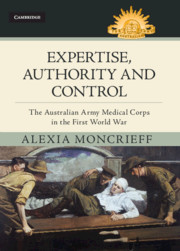Book contents
- Expertise, Authority and Control
- Other titles in the Australian Army History Series
- Expertise, Authority and Control
- Copyright page
- Contents
- Figures, maps and tables
- Preface
- Acknowledgements
- Note on style
- Abbreviations
- Introduction
- Chapter 1 Gallipoli
- Chapter 2 Medicine in the lines
- Chapter 3 The Western Front in 1918
- Chapter 4 A pleasant dose of medicine?
- Chapter 5 The most difficult problem
- Conclusion
- Notes
- Bibliography
- Index
Chapter 3 - The Western Front in 1918
The AAMC in mobile warfare
Published online by Cambridge University Press: 10 February 2020
- Expertise, Authority and Control
- Other titles in the Australian Army History Series
- Expertise, Authority and Control
- Copyright page
- Contents
- Figures, maps and tables
- Preface
- Acknowledgements
- Note on style
- Abbreviations
- Introduction
- Chapter 1 Gallipoli
- Chapter 2 Medicine in the lines
- Chapter 3 The Western Front in 1918
- Chapter 4 A pleasant dose of medicine?
- Chapter 5 The most difficult problem
- Conclusion
- Notes
- Bibliography
- Index
Summary
The European winter of 1917–18 was a time of change for the Australian Imperial Force. In Australia, two plebiscites to introduce conscription had failed, and plans to raise a sixth Australian division were scrapped. Recruits originally destined for this new division were distributed among the existing five divisions, which had suffered significant losses in the fighting in September and October 1917, during the Third Battle of Ypres. In November 1917, having been withdrawn from the line the month before, the five Australian divisions were reorganised into one Australian Corps and attached to the British Fourth Army. The British and New Zealand divisions that had been part of II ANZAC became the British XXII Corps, part of First Army. General Sir William Birdwood, who had been Commanding Officer of I ANZAC, was originally put in charge of the new corps, but in May 1918 he was made Commanding Officer of Fifth Army. As a result, Major General John Monash was promoted to lieutenant general; the Australian Corps was in his command from May onwards, marking the first time an Australian was in command of a fighting unit at corps level on the Western Front.1
Keywords
- Type
- Chapter
- Information
- Expertise, Authority and ControlThe Australian Army Medical Corps in the First World War, pp. 80 - 108Publisher: Cambridge University PressPrint publication year: 2020



